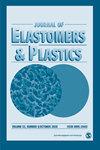Synthesis of Functional Syndiotactic Polystyrene Copolymers with Graft and Block Structures by Nitroxide-Mediated Living Radical Polymerization
IF 1.6
4区 材料科学
Q4 MATERIALS SCIENCE, MULTIDISCIPLINARY
引用次数: 19
Abstract
In this study, synthesis of controlled graft copolymers onto syndiotactic polystyrene using nitroxide-mediated living radical polymerization and 2, 2, 6, 6-tetramethyl-1-piperidinyloxy (TEMPO) iniferter is reported. Syndiotactic polystyrene has been synthesized using half-sandwich titanocene/ methylaluminoxane catalyst in homogenous conditions. Then, α-phenyl chloroacetylation of syndiotactic polystyrene was accomplished in a heterogeneous process using carbon disulfide as dispersing medium and α-phenyl chloroacetyl chloride and anhydrous aluminum chloride as acetylating agent and catalyst, respectively. Then, 1-hydroxy 2, 2, 6, 6-tetramethyl-1-piperidinyloxy (TEMPO-OH) was synthesized by the reduction of TEMPO with sodium ascorbate. This functional nitroxyl compound was coupled with arylated syndiotactic polystyrene. The graft copolymerizations of styrene and methyl styrene were initiated by arylated syndiotactic polystyrene carrying TEMPO groups as a macroinitiator. The product of polymerization was then heated in the presence of styrene and methyl styrene to form graft copolymer. The structure of obtained copolymer was investigated by 1H-NMR, and Fourier transform—infrared spectroscopy, and thermal behavior of copolymers was performed by differential scanning calorimetry analyses.氮氧基活性自由基聚合合成接枝和嵌段结构功能顺规聚苯乙烯共聚物
本文报道了用硝基自由基聚合和2,2,6,6 -四甲基-1-胡椒酰氧基(TEMPO)杂化剂在间二规聚苯乙烯上合成可控接枝共聚物。采用半夹心二茂钛/甲基铝氧烷催化剂,在均相条件下合成了Syndiotactic聚苯乙烯。然后以二硫化碳为分散介质,α-苯基氯乙酰化剂和无水氯化铝分别为乙酰化剂和催化剂,采用多相工艺对辛二规聚苯乙烯进行α-苯基氯乙酰化反应。然后用抗坏血酸钠还原TEMPO,合成1-羟基2,2,6,6 -四甲基-1-胡椒酰氧基(TEMPO- oh)。该功能性的硝基化合物与芳基化的间异规聚苯乙烯偶联。以带TEMPO基团的芳基化共规聚苯乙烯为宏观引发剂,引发了苯乙烯和甲基苯乙烯的接枝共聚反应。然后在苯乙烯和甲基苯乙烯存在下加热聚合产物,形成接枝共聚物。用1H-NMR和傅里叶变换红外光谱研究了共聚物的结构,并用差示扫描量热法分析了共聚物的热行为。
本文章由计算机程序翻译,如有差异,请以英文原文为准。
求助全文
约1分钟内获得全文
求助全文
来源期刊

Journal of Elastomers and Plastics
工程技术-材料科学:综合
CiteScore
3.30
自引率
5.90%
发文量
41
审稿时长
6 months
期刊介绍:
The Journal of Elastomers and Plastics is a high quality peer-reviewed journal which publishes original research on the development and marketing of elastomers and plastics and the area in between where the characteristics of both extremes are apparent. The journal covers: advances in chemistry, processing, properties and applications; new information on thermoplastic elastomers, reinforced elastomers, natural rubbers, blends and alloys, and fillers and additives.
 求助内容:
求助内容: 应助结果提醒方式:
应助结果提醒方式:


